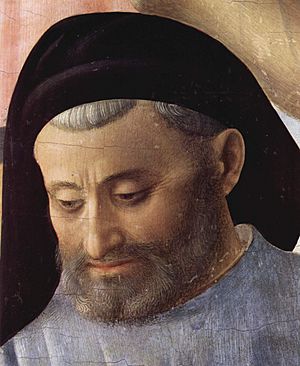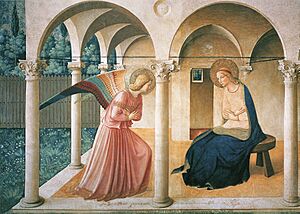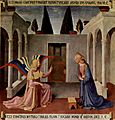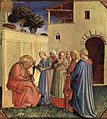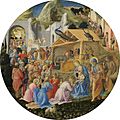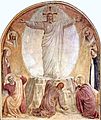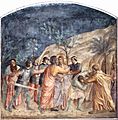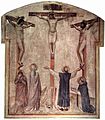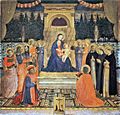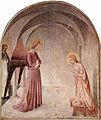Fra Angelico facts for kids
Fra Angelico (born around 1395 – died February 18, 1455) was a famous Italian painter from the early Renaissance period. A writer named Giorgio Vasari, who wrote about artists, said Fra Angelico had "a rare and perfect talent" for painting.
Fra Angelico was known by many names. When he was born, his name was Guido di Pietro. Later, people called him Fra Giovanni da Fiesole (which means Brother John from Fiesole). By the 1500s, when Giorgio Vasari wrote about him, he was known as Fra Giovanni Angelico (Brother Giovanni, who is like an Angel).
Italians often call him il Beato Angelico (the Blessed Angelico). This name stuck because people believed God blessed him with painting skills. He was also known for being a very good and holy man. In 1982, Pope John Paul II officially called him "Blessed Angelico." This means he is on his way to becoming a saint.
Vasari wrote about him: "It is impossible to say enough good things about this holy father. He was so humble and modest in everything he did. His pictures were painted with such skill and holy faith."
Contents
Fra Angelico's Life
Early Years and Becoming a Friar
Fra Angelico was born in a place called Mugello, near Fiesole in Tuscany, Italy. He was probably born around 1385–1387. He later died in Rome in 1455. We don't know much about his parents. He was baptized with the name Guido.
In 1407, he joined the Dominican Order in Fiesole. This is a group of religious brothers. In 1423, when he officially became a friar, he changed his name from Guido to Fra Giovanni (Brother John). People who join a holy order often choose a new name. Like other Dominican friars, he wore a white robe and a black cloak. He also shaved part of his head.
Fra Angelico had a brother named Benedetto who was also a Dominican friar. Benedetto painted illuminated manuscripts, which are books with beautiful pictures. Fra Angelico might have learned to paint these too. The convent of San Marco in Florence has some old books that people think he painted. Even though he was busy with other duties at the convents, he still found time to paint. His paintings quickly became famous. In 1418, he was paid for paintings he did in the church of Santo Stefano del Ponte.
Between 1418 and 1436, Fra Angelico painted a large altarpiece for the church in Fiesole. Parts of this painting were damaged over time. Some paint faded, and other artists tried to repair it, sometimes painting over his original work. The top part of this altarpiece is now in the National Gallery, London. It shows Christ in Glory, surrounded by more than 250 figures. It is a huge and beautiful artwork. Many people say it is one of the best paintings in the gallery.
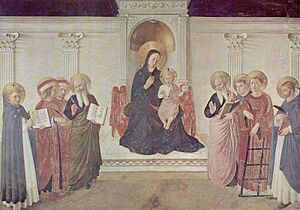
Painting at San Marco in Florence
In 1436, a new Dominican Convent of San Marco was started in Florence. Fra Angelico was one of the friars who moved there from Fiesole. This move was important for him because Florence was full of great artists he could learn from. The convent had a very rich supporter of the arts named Cosimo de' Medici. Cosimo loved to buy art for himself and his favorite churches. He even took one of the largest rooms, called cells, at the convent. He used it as a quiet place for religious thought. Fra Angelico painted a picture of the Magi at Bethlehem on the wall of Cosimo's cell.
Cosimo hired Fra Angelico to paint more pictures for the convent. All the friars' cells were upstairs around a square courtyard with a garden. On the wall at the top of the stairs, Fra Angelico painted a fresco (a painting done on wet plaster) of the Angel Gabriel telling the Blessed Virgin Mary about the birth of Jesus. This is one of his most famous paintings. Fra Angelico then began to paint a picture in each monk's cell. Each cell has a large painting with a round top on the wall next to the window. Fra Angelico painted at least six of these himself. Others were done by artists who copied his style. These pictures were meant to help the friars with their prayers.
In 1439, he finished one of his most famous works. This was the altarpiece for San Marco's Church, where the friars prayed. It shows the Madonna and Child on a throne, surrounded by saints from different times. They are all grouped together as if they were in a room in Heaven, talking about holy things. This type of painting is called a "Sacred Conversation." It became very popular later, but Fra Angelico's was one of the first.
Working for the Popes in the Vatican
In 1445, Pope Eugenius IV asked Fra Angelico to come to Rome. The Pope wanted him to paint frescoes in the Chapel of the Holy Sacrament at St Peter's. This chapel was later taken down to build the new St. Peter's Basilica, so Fra Angelico's work there was lost. Vasari says that one of the popes (either Eugenius or Pope Nicholas V) asked Fra Angelico if he wanted the important job of Archbishop of Florence. But Fra Angelico did not want such a high position. He suggested another friar for the job instead. In 1447, Fra Angelico went to the city of Orvieto with his student, Benozzo Gozzoli. They painted some pictures for the Cathedral there. Another of his students was Zanobi Strozzi, but he did not become as famous as Benozzo.
From 1447 to 1449, Fra Angelico was back at the Vatican. Pope Nicholas V had built a small chapel where he could pray privately. Fra Angelico and his students painted pictures there showing the lives of two young saints, St. Stephen and St. Lawrence. Both of them were "martyrs," meaning they were killed because of their Christian faith. This small chapel, with its bright colors and gold leaf decorations, looks like a jewel box. From 1449 until 1452, Fra Angelico was back at his old convent in Fiesole. There, he was the Prior, which means he was the head of the convent. Fra Angelico's students probably stayed in Rome to finish the work on the chapel.
Death and Becoming "Blessed"
In 1455, Fra Angelico returned to Rome. He probably went to check on the work in Pope Nicholas' Chapel. He died at the Dominican Convent and was buried in the church of Santa Maria sopra Minerva. Pope John Paul II officially called Fra Angelico "Blessed Angelico" on October 3, 1982. In 1984, the Pope made him the patron of Catholic artists.
Fra Angelico never wanted to be important. Even though he was very talented, he always stayed humble. He believed his most important job was to care for others. He always prayed before he started painting. He never changed his pictures later because he believed the Holy Spirit was guiding him. He painted many scenes of the Crucifixion (Jesus on the cross). It is said he would often cry while painting them.
The words on his grave say: "When you praise me, don't say that I am a famous painter. Instead, say that for love of Jesus, I gave everything that I had to the poor. The things that seem important on Earth are not the things that are important in Heaven. I am Brother John, from Florence, the flower of Tuscany."
Fra Angelico's Painting Style
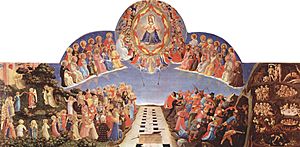
Fra Angelico painted during a time when art styles were changing a lot. These changes had started about a hundred years before his time with the artist Giotto. Fra Angelico would have seen Giotto's famous paintings of the "Life of Saint Francis" in the church of Santa Croce in Florence. In Giotto's paintings, the figures look more real and solid than in other paintings from the 1300s. Giotto was also very good at showing emotions on people's faces and actions that showed how they felt. His work greatly influenced every artist who saw it.
At the same time, rich people like Cosimo de Medici loved to show off their wealth. They often did this by ordering paintings with lots of bright colors and real gold backgrounds. The red color called "vermilion" was very expensive. But the most expensive color was a beautiful blue. It was made by grinding up a semi-precious stone called Lapis lazuli. This type of painting is called "International Gothic." Some artists of Fra Angelico's time were experts at making paintings that pleased very rich people. But other painters, like Masaccio, followed Giotto's style and painted in a simpler way.
Fra Angelico was able to paint in both styles. If the Pope or a wealthy family wanted an altarpiece or a fresco with gold and expensive bright colors, Fra Angelico could do it. But his most famous paintings have no gold and no bright colors. These are the simple, gentle paintings of the life of Jesus that he made for the friars in their cells at San Marco.
Gallery
This gallery shows stories from the life of Jesus. The square paintings are made with tempera paint. They are all parts of a big altarpiece and are about 25 cm wide. The "tondo" (round painting) is a small altarpiece about 1.4 meters wide. All the paintings with arched tops are frescos and were painted for the Dominican brothers.
-
The Naming of St. John the Baptist (1434 – 1435)
-
The Transfiguration
-
Mary Magdalene sees the risen Christ (c.1437 – 1446)
Related Pages
- Fra Angelico at The Metropolitan Museum of Art
Images for kids
-
The Adoration of the Magi is a round painting of the Adoration of the Magi. It is believed to be by Fra Angelico and Filippo Lippi and dates to around 1440–1460.
-
Saint Lawrence distributing alms (1447), in the Vatican. This painting uses expensive colors, gold leaf, and fancy designs, typical of art made for the Vatican.
-
The Madonna enthroned with Saints Cosmas and Damian, Saint Mark and Saint John, Saint Lawrence and three Dominicans, Saint Dominic, Saint Thomas Aquinas and Saint Peter Martyr; San Marco, Florence
See also
 In Spanish: Fra Angelico para niños
In Spanish: Fra Angelico para niños


